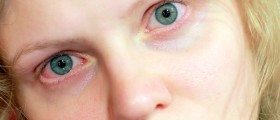
Conjunctivitis is an eye disease characterized by the inflammation of the retina. The inflammation is usually due to an infection or an allergy. Infectious conjunctivitis is often contagious and easily passed from one person to another.
What is conjunctivitis?
Conjunctivitis or pink eye is the most common eye disorder, especially in children. It is characterized by redness of the eye, swelling, irritation, itching, pain, watery eyes, crusting of the eyelids and photosensitivity.
This is not a dangerous eye disorder and it does not cause any permanent vision problems, even though during the infection the vision may be blurred or cloudy.
Acute conjunctivitis is a self-limited condition, which means that it goes away on its own within several days, even without specific treatment. However, home remedies, as well as over-the-counter topical medication, can be used to shorten the duration of the inflammation and to relieve the symptoms.
Causes of conjunctivitis in childhood
Conjunctivitis can be allergic or infectious. Children who have allergies are likely to develop conjunctivitis, especially during allergy seasons. Conjunctivitis is particularly associated with hay fever.
Infectious conjunctivitis is, in most cases, bacterial or viral and, less commonly, fungal. Most cases of bacterial conjunctivitis are caused by Haemophilus influenzae and Streptococcus pneumoniae. H. influenzae is commonly associated with middle ear infections and it accounts for more than 40% of all cases of conjunctivitis in childhood. S. pneumonia is responsible for about 10% of conjunctivitis cases and other bacteria that may cause this eye infection are S. aureus, bacteroides and Moraxella catarrhalis.
Viral conjunctivitis is more common and easily transmitted from one infected child to another, especially in schools and kindergartens. Adenovirus accounts for up to 20% of viral conjunctivitis and it is usually spread through contaminated instruments or environments, such as ophthalmologic tools and swimming pools.
It is very important to distinguish between viral and bacterial cases of conjunctivitis, because the treatment of the two types is completely different. Viral conjunctivitis is usually left to pass on its own, possibly using measures such as rest, multivitamins and proper hygiene. In more severe cases doctors may prescribe antiviral ointments or eye drops. Bacterial conjunctivitis, on the other hand, may require the use of antibiotics, also in form of ointments or eye drops.
Assuming that conjunctivitis is bacterial, without confirming it, can be dangerous because if viral conjunctivitis is treated with antibiotics over a prolonged period, it may lead to antibiotic resistance, irritation and recurring eye infections.






_f_280x120.jpg)










Your thoughts on this
Loading...